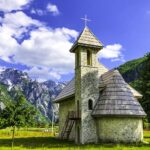Perched high above the medieval town of Kotor, the Castle of Kotor—also known as San Giovanni Fortress or St. John’s Fortress—stands as a testament to centuries of history, resilience, and architectural prowess. This formidable structure not only offers panoramic views of the Bay of Kotor but also invites visitors to traverse its ancient pathways, echoing tales of empires past.
🌟 Fun Facts and Curiosities About the Castle of Kotor
- A Multilayered History
The fortress’s origins trace back to the Byzantine era, with significant expansions during Venetian rule in the 15th and 16th centuries. - Strategic Significance
Its elevated position provided a strategic vantage point, allowing defenders to spot incoming threats from both land and sea, crucial for the protection of Kotor’s inhabitants. - Architectural Marvel
The fortifications encompass a series of walls, bastions, and towers that stretch over 4.5 kilometers, integrating seamlessly with the rugged terrain of Mount St. John. - UNESCO Recognition
The Castle of Kotor, along with the town’s fortifications, is part of the Natural and Culturo-Historical Region of Kotor, a UNESCO World Heritage Site since 1979 - The Ladder of Kotor
The ascent to the fortress is famously known as the “Ladder of Kotor,” comprising over 1,300 steps that wind through scenic landscapes, offering breathtaking views at every turn.
🧭 Travel Tips for Visiting the Castle of Kotor
- Best Time to Visit: Early mornings or late afternoons provide cooler temperatures and softer lighting, ideal for photography.
- Footwear: Wear sturdy shoes suitable for uneven and steep pathways.
- Hydration: Carry water, especially during warmer months, as the climb can be physically demanding.
- Entry Fee: A nominal fee is charged for access, contributing to the site’s maintenance and preservation.
- Guided Tours: Consider hiring a local guide to enrich your visit with historical insights and anecdotes.






